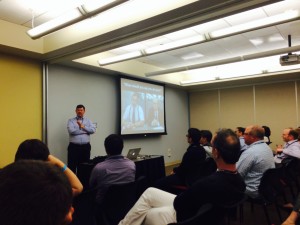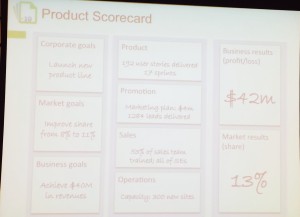Yesterday I attended Product Camp Silicon Valley at the PayPal campus in San Jose. It was my second time attending this in the past 4 years. If you haven’t been to a Product Camp before, I highly recommend it if you’re a Product Manager who wants to stay on top of the latest trends in Product Management.
The first session that I attended was “Has Agile broken Product Marketing?”, led by Steve Johnson (@sjohnson717) from Under 10 Consulting. The basic idea of this session was that we as Product Managers need to keep in mind that the Agile process was conceived as a development methodology and it’s really just one part of a Product Manager’s job. It doesn’t guarantee that you’re building the right thing and it has little to do with domain or market expertise that you need to be a well rounded Product Manager. Overall it was an excellent session with many good takeaways. Here are my notes from the session. You can download the slides from Steve’s site.
Steve started out by saying that this talk is not about beating up on Agile. There are wonderful aspects of Agile.
Make sure that your user stories are not just descriptions of tasks. What problems are you solving?
Some people in the organization miss the old Waterfall approach. Sales people and execs pine for Waterfall but they tend to forget that the roadmap was fiction. Nothing was ever delivered on time.
Steve gave an example of Agile using his recent kitchen remodel as an example. They worked with their contractor to design a very cool pull-out shelf for a KitchenAid blender. But after it was installed, they realized that there was no outlet in reach to plug it in. No problem – the contractor adjusted quickly to this and installed the outlet and they move forward. They used Agile. If this was Waterfall, this would be more of a big deal becasue the outlet wasn’t in the original requirements. There would be a new quote for the additional work and it would be a much more difficult process.
Steve recommends having just enough process to get the work done. Keep the number of artifacts to a minimum and also try to have a minimal number of products.
The Product Manager role used to be a business role but over the years it has become more technical. You shouldn’t lose sight of the business drivers that are driving your backlog. He gave an example of a guy that he saw at the airport who was flipping through index cards. When Steve asked what he was doing, he said that he was grooming his backlog. He asked him how he knew what the ranks should be. The guy replied that he decided for himself which user stories were the most important. Don’t fall into this trap. When you’re grooming your backlog, you should always be working with your customers and stakeholders to inform your decisions related to ranking of user stories.
Other tips…
Another thing to avoid is building a cool feature that is targeted to a personna that is not one of your target personnas.
Remember that the Sales group is going to need to sell your product and also keep in mind the operational impact.
Steve mentioned a phrase that a fellow product manager named Saeed Kahn likes to say: “Nail it before you scale it.”
For example, you can show a new product release to two sales people before you show it to anyone else from Sales. Make sure that they understand the value proposition and know how to sell it. Once you’ve nailed it with the two sales people, then you can roll out to the rest of the Sales organization.
Extend your view beyond just the “nerdy” parts of the product.
Remember – one sentence from an exec (“I want this feature”) can be months of work for the Product team. To avoid a lot of wasted work, every week you should validate what you are building with that exec to make sure you’re still on course. You want to avoid getting to the end and them saying “That isn’t at all what I wanted.”
Some of the developers that Steve has worked with came up with a term called “Requirements aging”. When you get a feature request from someone, put in on the shelf for a while. Give it some time and the requirement will surely change.
What is the difference between the Product Owner role in Agile and the Product Manager’s role?Product owners are inside the building and represent the Inbound product management functions. Product Managers should be “outside the building” and represent the Outbound role too.
There are different types of product managers…
– Tech
– Biz
– Market
How many PM’s should you have in your department?
How many departments are hiding head count in Product Management?
You can keep the PM team smaller if departments aren’t pulling PM’s in too much for functions such as Sales demo’s.
Don’t be the product managers who hates customers.
Four areas of expertise for a product manager:
– Business
– Market
– Domain
– Technology
Most product managers don’t have all of these skills. Two out of four is more common.
Many technology companies think they can find people with all four but this is very rare.
Best thing is to have a mix of people in your PM group representing these different Skills areas.
Wrapping up…
We’ve focused so much in product because that’s where all the noise is, but remember to work on your skills in the other areas to be a well rounded Product Manager.


You can download the slides I used in the session from http://wp.me/P3gnXx-CP
Thanks for the nice write-up. Did I really say all those smart things?? 🙂
Indeed you did! Thanks for a very informative session and for the link to the slides.
Pingback: In case you missed ProductCamp Silicon Valley 2014… | On Product Management